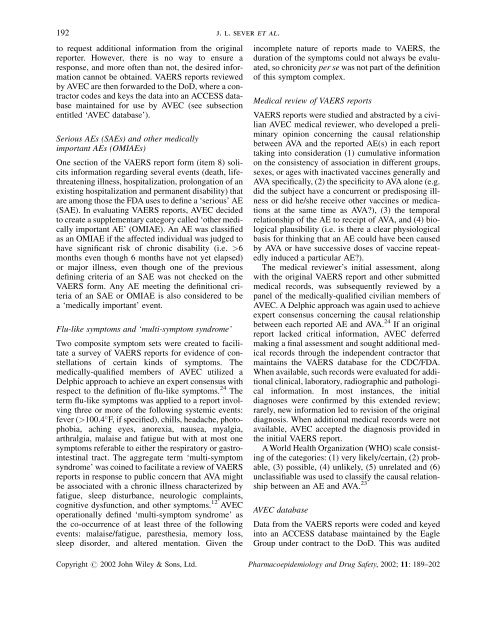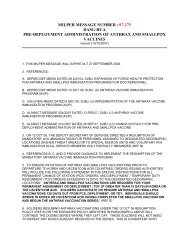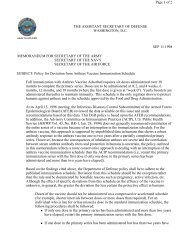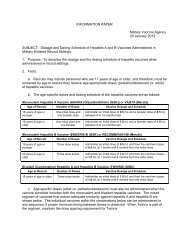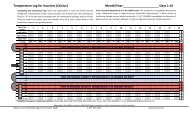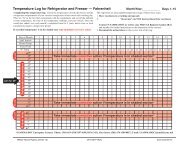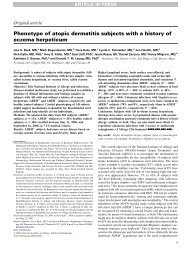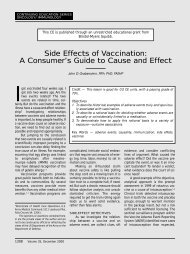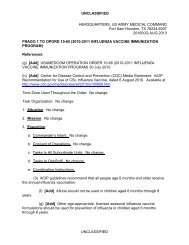Safety of anthrax vaccine: a review by the Anthrax Vaccine Expert ...
Safety of anthrax vaccine: a review by the Anthrax Vaccine Expert ...
Safety of anthrax vaccine: a review by the Anthrax Vaccine Expert ...
You also want an ePaper? Increase the reach of your titles
YUMPU automatically turns print PDFs into web optimized ePapers that Google loves.
192 j. l. sever et al.<br />
to request additional information from <strong>the</strong> original<br />
reporter. However, <strong>the</strong>re is no way to ensure a<br />
response, and more <strong>of</strong>ten than not, <strong>the</strong> desired information<br />
cannot be obtained. VAERS reports <strong>review</strong>ed<br />
<strong>by</strong> AVEC are <strong>the</strong>n forwarded to <strong>the</strong> DoD, where a contractor<br />
codes and keys <strong>the</strong> data into an ACCESS database<br />
maintained for use <strong>by</strong> AVEC (see subsection<br />
entitled ‘AVEC database’).<br />
Serious AEs (SAEs) and o<strong>the</strong>r medically<br />
important AEs (OMIAEs)<br />
One section <strong>of</strong> <strong>the</strong> VAERS report form (item 8) solicits<br />
information regarding several events (death, lifethreatening<br />
illness, hospitalization, prolongation <strong>of</strong> an<br />
existing hospitalization and permanent disability) that<br />
are among those <strong>the</strong> FDA uses to define a ‘serious’ AE<br />
(SAE). In evaluating VAERS reports, AVEC decided<br />
to create a supplementary category called ‘o<strong>the</strong>r medically<br />
important AE’ (OMIAE). An AE was classified<br />
as an OMIAE if <strong>the</strong> affected individual was judged to<br />
have significant risk <strong>of</strong> chronic disability (i.e. >6<br />
months even though 6 months have not yet elapsed)<br />
or major illness, even though one <strong>of</strong> <strong>the</strong> previous<br />
defining criteria <strong>of</strong> an SAE was not checked on <strong>the</strong><br />
VAERS form. Any AE meeting <strong>the</strong> definitional criteria<br />
<strong>of</strong> an SAE or OMIAE is also considered to be<br />
a ‘medically important’ event.<br />
Flu-like symptoms and ‘multi-symptom syndrome’<br />
Two composite symptom sets were created to facilitate<br />
a survey <strong>of</strong> VAERS reports for evidence <strong>of</strong> constellations<br />
<strong>of</strong> certain kinds <strong>of</strong> symptoms. The<br />
medically-qualified members <strong>of</strong> AVEC utilized a<br />
Delphic approach to achieve an expert consensus with<br />
respect to <strong>the</strong> definition <strong>of</strong> flu-like symptoms. 24 The<br />
term flu-like symptoms was applied to a report involving<br />
three or more <strong>of</strong> <strong>the</strong> following systemic events:<br />
fever (>100.4 F, if specified), chills, headache, photophobia,<br />
aching eyes, anorexia, nausea, myalgia,<br />
arthralgia, malaise and fatigue but with at most one<br />
symptoms referable to ei<strong>the</strong>r <strong>the</strong> respiratory or gastrointestinal<br />
tract. The aggregate term ‘multi-symptom<br />
syndrome’ was coined to facilitate a <strong>review</strong> <strong>of</strong> VAERS<br />
reports in response to public concern that AVA might<br />
be associated with a chronic illness characterized <strong>by</strong><br />
fatigue, sleep disturbance, neurologic complaints,<br />
cognitive dysfunction, and o<strong>the</strong>r symptoms. 12 AVEC<br />
operationally defined ‘multi-symptom syndrome’ as<br />
<strong>the</strong> co-occurrence <strong>of</strong> at least three <strong>of</strong> <strong>the</strong> following<br />
events: malaise/fatigue, pares<strong>the</strong>sia, memory loss,<br />
sleep disorder, and altered mentation. Given <strong>the</strong><br />
incomplete nature <strong>of</strong> reports made to VAERS, <strong>the</strong><br />
duration <strong>of</strong> <strong>the</strong> symptoms could not always be evaluated,<br />
so chronicity per se was not part <strong>of</strong> <strong>the</strong> definition<br />
<strong>of</strong> this symptom complex.<br />
Medical <strong>review</strong> <strong>of</strong> VAERS reports<br />
VAERS reports were studied and abstracted <strong>by</strong> a civilian<br />
AVEC medical <strong>review</strong>er, who developed a preliminary<br />
opinion concerning <strong>the</strong> causal relationship<br />
between AVA and <strong>the</strong> reported AE(s) in each report<br />
taking into consideration (1) cumulative information<br />
on <strong>the</strong> consistency <strong>of</strong> association in different groups,<br />
sexes, or ages with inactivated <strong>vaccine</strong>s generally and<br />
AVA specifically, (2) <strong>the</strong> specificity to AVA alone (e.g.<br />
did <strong>the</strong> subject have a concurrent or predisposing illness<br />
or did he/she receive o<strong>the</strong>r <strong>vaccine</strong>s or medications<br />
at <strong>the</strong> same time as AVA?), (3) <strong>the</strong> temporal<br />
relationship <strong>of</strong> <strong>the</strong> AE to receipt <strong>of</strong> AVA, and (4) biological<br />
plausibility (i.e. is <strong>the</strong>re a clear physiological<br />
basis for thinking that an AE could have been caused<br />
<strong>by</strong> AVA or have successive doses <strong>of</strong> <strong>vaccine</strong> repeatedly<br />
induced a particular AE?).<br />
The medical <strong>review</strong>er’s initial assessment, along<br />
with <strong>the</strong> original VAERS report and o<strong>the</strong>r submitted<br />
medical records, was subsequently <strong>review</strong>ed <strong>by</strong> a<br />
panel <strong>of</strong> <strong>the</strong> medically-qualified civilian members <strong>of</strong><br />
AVEC. A Delphic approach was again used to achieve<br />
expert consensus concerning <strong>the</strong> causal relationship<br />
between each reported AE and AVA. 24 If an original<br />
report lacked critical information, AVEC deferred<br />
making a final assessment and sought additional medical<br />
records through <strong>the</strong> independent contractor that<br />
maintains <strong>the</strong> VAERS database for <strong>the</strong> CDC/FDA.<br />
When available, such records were evaluated for additional<br />
clinical, laboratory, radiographic and pathological<br />
information. In most instances, <strong>the</strong> initial<br />
diagnoses were confirmed <strong>by</strong> this extended <strong>review</strong>;<br />
rarely, new information led to revision <strong>of</strong> <strong>the</strong> original<br />
diagnosis. When additional medical records were not<br />
available, AVEC accepted <strong>the</strong> diagnosis provided in<br />
<strong>the</strong> initial VAERS report.<br />
A World Health Organization (WHO) scale consisting<br />
<strong>of</strong> <strong>the</strong> categories: (1) very likely/certain, (2) probable,<br />
(3) possible, (4) unlikely, (5) unrelated and (6)<br />
unclassifiable was used to classify <strong>the</strong> causal relationship<br />
between an AE and AVA. 23<br />
AVEC database<br />
Data from <strong>the</strong> VAERS reports were coded and keyed<br />
into an ACCESS database maintained <strong>by</strong> <strong>the</strong> Eagle<br />
Group under contract to <strong>the</strong> DoD. This was audited<br />
Copyright # 2002 John Wiley & Sons, Ltd. Pharmacoepidemiology and Drug <strong>Safety</strong>, 2002; 11: 189–202


